
Psychodynamic, Behavioral and Cognitive Theory
- Subject:
- Career and Technical Education
- Criminal Justice
- Material Type:
- Interactive
- Provider:
- Michigan Virtual
- Date Added:
- 07/29/2019

Psychodynamic, Behavioral and Cognitive Theory

Psychology and Criminology Slideshow

Insanity Defense Slideshow
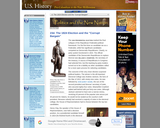
The 1824 presidential election marked the final collapse of the Republican-Federalist political framework. For the first time no candidate ran as a Federalist, while five significant candidates competed as Democratic-Republicans. Clearly, no party system functioned in 1824. The official candidate of the Democratic-Republicans to replace Monroe was William H. Crawford, the secretary of the treasury. A caucus of Republicans in Congress had selected him, but this backing by party insiders turned out to be a liability as other candidates called for a more open process for selecting candidates.
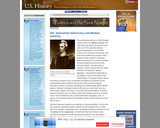
The presidential election of 1828 brought a great victory for Andrew Jackson. Not only did he get almost 70 percent of the votes cast in the electoral college, popular participation in the election soared to an unheard of 60 percent. This more than doubled the turnout in 1824; Jackson clearly headed a sweeping political movement. His central message remained largely the same from the previous election, but had grown in intensity. Jackson warned that the nation had been corrupted by "special privilege," characterized especially by the policies of the Second Bank of the United States.
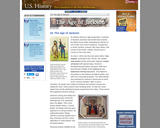
On July 4, 1826, less than two years before "King Andrew" ascended to the "throne," the Yankee John Adams and the aristocratic Virginian Thomas Jefferson both passed away. America's Revolutionary generation was gone. With them went the last vestiges of the Federalist and Republican parties. This helped to bring about a new balance of political power, and with it two new political parties. The 1828 election was portrayed by Jackson's Democrats as proof of the "common people's right" to pick a President. No longer were Virginia Presidents and northern money-men calling the shots. Class systems were breaking down. To that end, some states had recently abolished property requirements for voting. These poorer folk supported General Jackson.
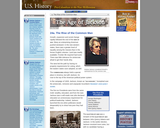
Growth, expansion and social change rapidly followed the end of the War of 1812. Many an enterprising American pushed westward. In the new western states, there was a greater level of equality among the masses than in the former English colonies. Land was readily available. Frontier life required hard work. There was little tolerance for aristocrats afraid to get their hands dirty.

The Founders of the nation feared a tyrannical President they believed that only a strong Congress could best represent the people. Jackson felt that the Congress was not representing the people that they were acting like an aristocracy. Jackson took the view that only the President could be trusted to stand for the will of the people against the aristocratic Congress. Jackson's weapon was the veto. "Andy Veto" used this power more often than all six previous Presidents combined.
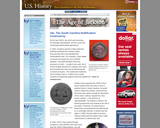
In 1828, Congress passed a high protective tariff that infuriated the southern states because they felt it only benefited the industrialized north. For example, a high tariff on imports increased the cost of British textiles. This tariff benefited American producers of cloth mostly in the north. But it shrunk English demand for southern raw cotton and increased the final cost of finished goods to American buyers. The southerners looked to Vice President John C. Calhoun from South Carolina for leadership against what they labeled the "Tariff of Abominations."
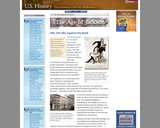
The Second Bank of the United States was chartered in 1816 for a term of 20 years. The time limitation reflected the concerns of many in Congress about the concentration of financial power in a private corporation. The Bank of the United States was a depository for federal funds and paid national debts, but it was answerable only to its directors and stockholders and not to the electorate.
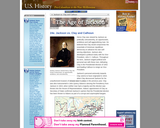
Henry Clay was viewed by Jackson as politically untrustworthy, an opportunistic, ambitious and self-aggrandizing man. He believed that Clay would compromise the essentials of American republican democracy to advance his own self-serving objectives. Jackson also developed a political rivalry with his Vice-President, John C. Calhoun. Throughout his term, Jackson waged political and personal war with these men, defeating Clay in the Presidential election of 1832 and leading Calhoun to resign as Vice-President.
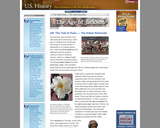
Not everyone was included in the new Jacksonian Democracy. There was no initiative from Jacksonian Democrats to include women in political life or to combat slavery. But, it was the Native American who suffered most from Andrew Jackson's vision of America.

In 1790, Samuel Slater built the first factory in America, based on the secrets of textile manufacturing he brought from England. He built a cotton-spinning mill in Pawtucket, Rhode Island, soon run by water-power. Over the next decade textiles was the dominant industry in the country, with hundreds of companies created.

Ever since the days of Jamestown and Plymouth, America was moving West. Trail blazers had first hewn their way on foot and by horseback. Homesteaders followed by wagon and by either keelboat or bargeboat, bringing their possessions with them. Yet, real growth in the movement of people and goods west started with the canal.

The development of railroads was one of the most important phenomena of the Industrial Revolution. With their formation, construction and operation, they brought profound social, economic and political change to a country only 50 years old. Over the next 50 years, America would come to see magnificent bridges and other structures on which trains would run, awesome depots, ruthless rail magnates and the majesty of rail locomotives crossing the country.
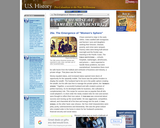
Money equaled status, and increased status opened more doors of opportunity for the upwardly mobile. The home was the perfect location to display the wealth. The husband had to be out in the public sphere creating the wealth, but his wife was free to manage the private sphere, the "women's sphere." Together, a successful husband and wife created a picture of perfect harmony.
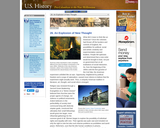
What did it mean to think like an American? Once the colonists had thrown off the burdens and controls of England, the possibilities for political, social and artistic creativity and experimentation seemed limitless.
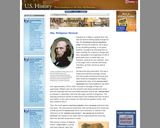
Religion was not only revived it was being transformed. Gone were the warnings that man was totally depraved; that he was "predestined" to salvation or damnation; that God was angry and full of vengeance. The amazing assurance that life on earth had its own rewards and was not just a way station on the road to heaven (or hell) touched people's hearts. And they rushed to hear it.
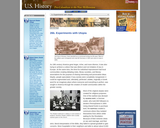
As 19th century America grew larger, richer, and more diverse, it was also trying to achieve a culture that was distinct and not imitative of any in Europe. At the same time, the thirst for individual improvement had local communities creating debating clubs, library societies, and literary associations for the purpose of sharing interesting and provocative ideas. Maybe, people speculated, if any society were completely reorganized, it could be regenerated and, ultimately, perfected. Utopia, originally a Greek word for an imaginary place where everyone and everything is perfect, was sought in America through the creation of model communities within the greater society.
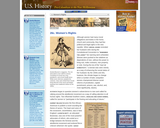
During the era of the "cult of domesticity," a woman was seen merely as a way of enhancing the social status of her husband. By the 1830s and 40s, however, the climate began to change when a number of bold, outspoken women championed diverse social reforms of prostitution, capital punishment, prisons, war, alcohol, and, most significantly, slavery.